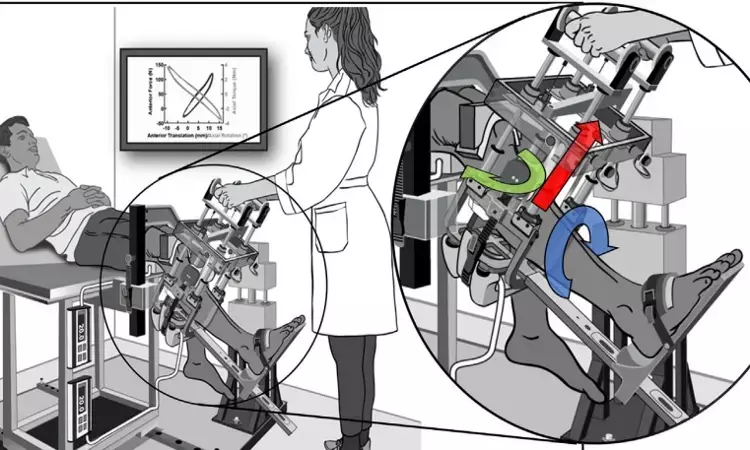- Home
- Medical news & Guidelines
- Anesthesiology
- Cardiology and CTVS
- Critical Care
- Dentistry
- Dermatology
- Diabetes and Endocrinology
- ENT
- Gastroenterology
- Medicine
- Nephrology
- Neurology
- Obstretics-Gynaecology
- Oncology
- Ophthalmology
- Orthopaedics
- Pediatrics-Neonatology
- Psychiatry
- Pulmonology
- Radiology
- Surgery
- Urology
- Laboratory Medicine
- Diet
- Nursing
- Paramedical
- Physiotherapy
- Health news
- Fact Check
- Bone Health Fact Check
- Brain Health Fact Check
- Cancer Related Fact Check
- Child Care Fact Check
- Dental and oral health fact check
- Diabetes and metabolic health fact check
- Diet and Nutrition Fact Check
- Eye and ENT Care Fact Check
- Fitness fact check
- Gut health fact check
- Heart health fact check
- Kidney health fact check
- Medical education fact check
- Men's health fact check
- Respiratory fact check
- Skin and hair care fact check
- Vaccine and Immunization fact check
- Women's health fact check
- AYUSH
- State News
- Andaman and Nicobar Islands
- Andhra Pradesh
- Arunachal Pradesh
- Assam
- Bihar
- Chandigarh
- Chattisgarh
- Dadra and Nagar Haveli
- Daman and Diu
- Delhi
- Goa
- Gujarat
- Haryana
- Himachal Pradesh
- Jammu & Kashmir
- Jharkhand
- Karnataka
- Kerala
- Ladakh
- Lakshadweep
- Madhya Pradesh
- Maharashtra
- Manipur
- Meghalaya
- Mizoram
- Nagaland
- Odisha
- Puducherry
- Punjab
- Rajasthan
- Sikkim
- Tamil Nadu
- Telangana
- Tripura
- Uttar Pradesh
- Uttrakhand
- West Bengal
- Medical Education
- Industry
Novel Arthrometer may help Quantify Vivo Knee Laxity in Three Planes Following Total Knee Arthroplasty

Novel Arthrometer for Quantifying In Vivo Knee Laxity in Three Planes Following Total Knee Arthroplasty
Knee instability is a leading cause of dissatisfaction following total knee arthroplasty (TKA). Instability can involve abnormal laxity in multiple directions including varus-valgus (VV) angulation, anterior-posterior (AP) translation, and internal-external rotation (IER).
Quantitative and objective tools to measure knee joint laxity preoperatively and postoperatively in multiple planes of motion are limited. Most devices for quantitatively measuring clinical, in vivo laxity (ie, arthrometers) operate in a single plane. No existing arthrometer objectively quantifies knee laxity in all three of these directions.
David Z. Shamritsky et al conducted a study to verify the safety and assess reliability of a novel multiplanar arthrometer. The study was conducted at Hospital for Special Surgery, New York. It has been published in ‘The Journal of Arthroplasty.’
The arthrometer utilized a five degree-of-freedom instrumented linkage. Two examiners each conducted two tests on the leg that had received a TKA of 20 patients (mean age 65 years (range, 53-75); 9 men, 11 women), with nine and eleven distinct patients tested at 3-month and 1-year postoperative time points, respectively. AP forces from -10 to 30 Newtons, VV moments of ±3 Newton-meters, and IER moments of ±2.5 Newton-meters were applied to each subject’s replaced knee. Severity and location of knee pain during testing were assessed using a visual analog scale. Intraexaminer and interexaminer reliabilities were characterized using intraclass correlation coefficients.
Key findings of the study were:
• All subjects successfully completed testing.
• Pain during testing averaged 0.7 (out of possible 10; range, 0-2.5).
• Intraexaminer reliability was >0.77 for all loading directions and examiners.
• Interexaminer reliability and 95% confidence intervals were 0.85 (0.66-0.94), 0.67 (0.35-0.85), and 0.54 (0.16-0.79) in the VV, IER, and AP directions, respectively.
The authors commented - “In conclusion, we established a novel arthrometer that enables safe, time efficient, quantitative, and objective measurement of VV, AP, and IER knee laxities in a TKA population. Our arthrometer will enable research regarding laxity in multiple planes and their relation to clinical outcomes.”
Further reading:
Novel Arthrometer for Quantifying In Vivo Knee Laxity in Three Planes Following Total Knee Arthroplasty
David Z. Shamritsky, Erin E. Berube et al
The Journal of Arthroplasty 38 (2023) S190 - S195
https://doi.org/10.1016/j.arth.2023.02.030
MBBS, Dip. Ortho, DNB ortho, MNAMS
Dr Supreeth D R (MBBS, Dip. Ortho, DNB ortho, MNAMS) is a practicing orthopedician with interest in medical research and publishing articles. He completed MBBS from mysore medical college, dip ortho from Trivandrum medical college and sec. DNB from Manipal Hospital, Bengaluru. He has expirence of 7years in the field of orthopedics. He has presented scientific papers & posters in various state, national and international conferences. His interest in writing articles lead the way to join medical dialogues. He can be contacted at editorial@medicaldialogues.in.
Dr Kamal Kant Kohli-MBBS, DTCD- a chest specialist with more than 30 years of practice and a flair for writing clinical articles, Dr Kamal Kant Kohli joined Medical Dialogues as a Chief Editor of Medical News. Besides writing articles, as an editor, he proofreads and verifies all the medical content published on Medical Dialogues including those coming from journals, studies,medical conferences,guidelines etc. Email: drkohli@medicaldialogues.in. Contact no. 011-43720751


